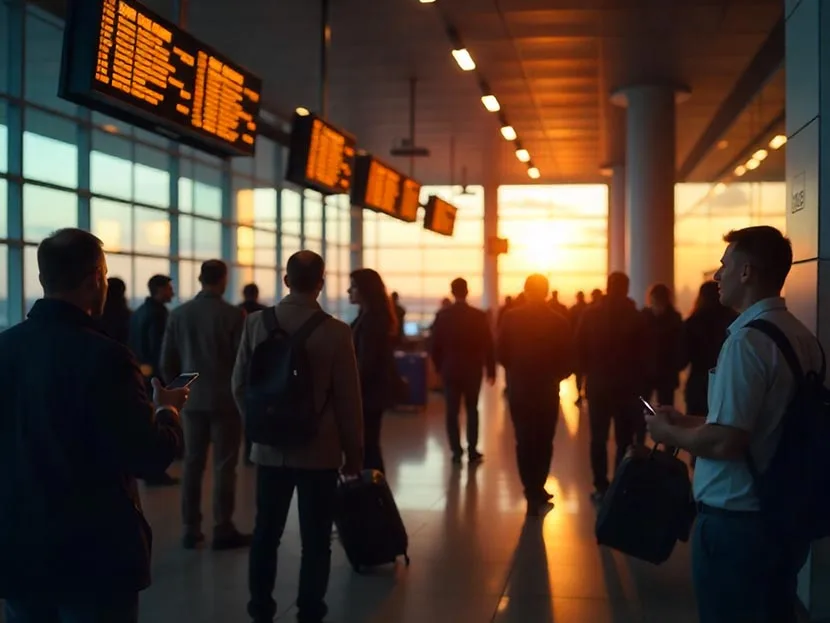Tuesday, July 22, 2025

New travel turmoil is on the horizon as American Airlines, United, JetBlue, and Avelo announce major cuts to their flights and routes. These drastic reductions, set to take effect in August 2025, have left many travelers uncertain about their travel plans. As these major airlines scale back operations, the ripple effect is already being felt by passengers who now face fewer options, potential delays, and disrupted itineraries.
With fewer available flights and reduced service on key routes, travelers will need to be more vigilant than ever in planning their trips. This move comes at a time when airlines are dealing with a host of challenges, from rising costs to shifting demand patterns. As American Airlines, United, JetBlue, and Avelo slash flights and routes, it’s essential for travelers to stay updated on these changes and consider alternatives to avoid any disruptions in their plans.
American Airlines Struggles in August 2025: Flight Cancellations and Disputes
American Airlines, once a leader in the U.S. aviation industry, is facing significant challenges that are affecting both its performance and customer experience. As the airline struggles to regain momentum in a fiercely competitive market, it has announced that it will be canceling hundreds of flights starting in August 2025. The airline’s challenges are rooted in strategic missteps, an inefficient route network, and a lack of investment in premium services compared to rivals like United Airlines and Delta Air Lines. This disruption comes amid heightened competition and a demand for better service, with American Airlines cutting over 70 weekly departures from its schedule in August.
The cuts come at a time when American Airlines is also in the midst of a dispute over gate space at Chicago O’Hare International Airport, further compounding its operational struggles. The changes are expected to impact many travelers, especially those who rely on key routes out of Chicago. For travelers planning flights with American Airlines, it’s critical to be aware of these cancellations and possible delays.
What Routes Are Being Affected by American Airlines Cancellations?
Among the routes being impacted, several key connections from Chicago O’Hare are seeing cuts. American Airlines is trimming down weekly flights between Chicago and major U.S. cities. The route between Chicago and Dallas/Fort Worth, one of the airline’s busiest, will see a reduction of 13 weekly departures, down from 98 to 85. Other routes that are affected include Chicago to Wilmington (ILM), El Paso (ELP), New York LaGuardia (LGA), Kansas City (MCI), and Pittsburgh (PIT), with a combined total of over 30 weekly departures removed from the schedule.
This change comes after a detailed review of American’s flight schedule in May 2025, where the airline made decisions to adjust its capacity, particularly on routes with lower demand or underperforming operations. While American Airlines will still be offering 16.5% more weekly departures at Chicago O’Hare compared to 2024, the cancellation of so many flights is bound to cause disruption for passengers relying on these services.
The Chicago O’Hare Gate Dispute: What It Means for Travelers
American Airlines’ ongoing gate dispute at Chicago O’Hare has added another layer of uncertainty for travelers. The airline is set to lose four gates at the airport, which would significantly impact its operations, leading to fewer arrivals and departures from the airport. American Airlines argues that this move violates a 2018 agreement with the city of Chicago and has filed a lawsuit, asking a federal judge to block the transfer of the gates.
Gate allocation decisions at major airports like O’Hare are crucial for airlines, as they directly affect the number of flights an airline can operate. Losing these gates could further disrupt American’s already strained operations, leading to more cancellations, delays, and capacity issues, especially on high-demand routes such as Chicago to New York, Dallas, and other major destinations.
Why American Airlines Is Struggling: A Broken Strategy?
American Airlines’ difficulties can be traced back to several strategic missteps that have left it trailing behind competitors like Delta and United. One of the key errors was its decision to focus heavily on pushing corporate travel customers to book directly on its site, which led to the removal of fares from corporate booking channels. This move, intended to reduce commission payments to third-party channels, ended up sending customers to rival airlines, which were more efficient in meeting the needs of business travelers.
Additionally, American has failed to match the investments made by competitors in premium services, such as first-class cabins, upgraded lounges, and overall service. Both United and Delta have invested heavily in enhancing the premium experience for travelers, which has been a key factor in maintaining their competitiveness. In comparison, American Airlines has been slow to adapt and innovate, particularly in the post-Covid era when travelers are increasingly demanding a better, more seamless experience.
Impact on Travelers and What You Need to Know
The cancellations and operational struggles are a wake-up call for American Airlines, and they are likely to impact passengers who have booked flights with the airline for August 2025 and beyond. Travelers should be proactive in checking the status of their flights, especially if they are flying from Chicago O’Hare or on one of the affected routes. American Airlines is expected to provide updates on flight changes, but passengers should also be prepared for possible delays or rescheduling.
For US travelers who were planning to book with American Airlines, it may be worth considering alternative carriers, especially for high-demand routes. Given the ongoing gate dispute at O’Hare and the cuts to service, travelers should carefully review their travel plans and consider booking with other airlines that offer more consistent service and reliability.
The Future of American Airlines: Will the Carrier Recover?
While American Airlines is facing tough times, it is not the only carrier navigating challenges in the competitive U.S. airline industry. However, the airline’s inability to keep up with rivals in terms of service offerings and its strained operational capacity could impact its long-term recovery. Whether American can regain its competitive edge depends on its ability to adapt, innovate, and address the current logistical challenges it faces, particularly with gate space and flight cancellations.
As the airline struggles to make necessary adjustments, passengers are left to deal with the short-term consequences, including flight cancellations and route reductions. The need for sustainable, customer-focused strategies has never been clearer, and American Airlines must act swiftly to rebuild trust with its customer base.
U.S. Airlines Reduce Flights in August 2025: A Sign of the Times
In a surprising move that has sent ripples across the travel industry, several U.S. airlines, including American Airlines, United Airlines, and JetBlue, are making significant cuts to their flight schedules beginning in August 2025. These adjustments come as a result of shifting demand patterns, economic pressures, and operational constraints. Travelers planning trips this summer should be aware of the growing impact of these changes, as the airline industry grapples with post-pandemic recovery and rising travel costs.
American Airlines, a key player in the U.S. market, has already announced the cancellation of over 70 weekly departures starting in August. This marks a sharp contrast to its competitors, United and Delta, who are also scaling back their flight offerings in response to economic uncertainty and decreased demand on certain routes. As airlines attempt to optimize their flight schedules and streamline operations, the ripple effect on passengers is becoming increasingly apparent. With less available capacity, many travelers are facing increased competition for seats, delays, and disruptions to their travel plans.
American Airlines Takes the Lead in Cutting Flights
American Airlines has become the most prominent airline making cuts in August, slashing over 70 weekly departures from its planned schedule. The most affected routes include major connections from Chicago O’Hare International Airport to key domestic destinations like Dallas/Fort Worth, Wilmington, El Paso, New York LaGuardia, Kansas City, and Pittsburgh. While these cuts affect a relatively small percentage of American’s total flight offerings, they highlight a growing trend of operational adjustments designed to cope with demand fluctuations.
American Airlines’ decision to reduce flights, particularly from its Chicago hub, comes amid a gate dispute at Chicago O’Hare. The airline is in a legal battle with the city, alleging that the loss of four gates at the airport would significantly hamper its ability to operate efficiently. This ongoing dispute only compounds the airline’s flight reduction strategy, potentially resulting in even fewer available routes as the situation develops. American Airlines plans to increase its overall weekly departures by 16.5% compared to the previous year, but the cuts to specific routes will inevitably affect travelers’ plans.
United Airlines Faces Similar Challenges with Flight Reductions
United Airlines is not immune to the pressures of overtourism and market shifts. In fact, the carrier is also making adjustments to its flight offerings starting in August. United has planned a 4% reduction in domestic flights, responding to both a decline in business travel and soft demand in specific regions. The airline’s decision to reduce capacity is designed to optimize operations and limit the financial strain caused by excess flight availability, especially as corporate travel continues to lag behind pre-pandemic levels.
This move comes after a period of strong demand recovery, particularly in leisure travel. However, with economic uncertainties still looming, United is opting for a more conservative flight schedule. The airline is strategically focusing on high-demand routes and reducing service to certain secondary markets, which could leave travelers scrambling to find alternative options. This shift emphasizes the importance of staying flexible when booking flights during uncertain times.
JetBlue Adjusts Its Strategy: Flight Cancellations and Route Cuts
JetBlue, which has long been a key competitor in the U.S. domestic market, is also revising its schedule for the remainder of 2025. With a primary focus on reducing costs and maintaining operational efficiency, the airline has announced it will cancel several routes in August 2025. Affected routes include popular connections from New York’s JFK Airport to destinations like Austin, Houston, Miami, and London Gatwick. JetBlue is also ceasing operations on other routes such as Westchester to Charleston, SC, and Jacksonville to Fort Lauderdale, FL.
This strategy is a direct response to the softer-than-expected travel demand and increasing costs associated with running less profitable routes. In addition to reducing flights, JetBlue is looking at long-term cost-cutting measures, including fleet optimization and reassessing its overall flight schedule. The airline’s strategy to reduce its unprofitable routes is a necessary step to maintain financial stability, but it does leave travelers with fewer choices when booking certain popular routes.
Avelo Airlines Makes a Major West Coast Exit
Avelo Airlines, which has grown rapidly in the past few years by offering low-cost flights on secondary routes, has decided to pull out of the West Coast market. The airline is closing its Hollywood Burbank base and ceasing all operations to and from California by December 2025. This unexpected exit is due to underperformance and the competitive pressures faced by the low-cost carrier. Avelo’s departure from the West Coast marks the end of a key expansion strategy that had been intended to capitalize on the growing demand for budget flights to and from California.
The airline’s decision to pull back is a direct reflection of the difficulties low-cost carriers face in maintaining profitability while competing with larger, more established airlines. With fewer routes and less capacity, travelers seeking affordable options will have fewer choices on the West Coast, potentially leading to higher fares from other carriers.
Other Airlines Scale Back Their Operations
Other U.S. airlines, including Frontier and Silver Airways, are also scaling back operations. Frontier Airlines, known for its ultra-low-cost model, has made flight reductions as part of a strategy to address softer demand in certain markets. The airline continues to focus on its core business of budget travel, but it must adjust its flight offerings to maintain financial health. Similarly, Silver Airways, which previously offered regional services, abruptly ceased operations in mid-2025 due to financial challenges and a restructuring process.
What Travelers Need to Know
As airlines across the U.S. make adjustments to their schedules, travelers need to be vigilant when planning their trips. Flight cancellations and reductions are becoming a growing reality for passengers, particularly as airlines shift their strategies in response to economic challenges. If you’re traveling in August 2025 or beyond, here’s what you need to know:
- Check Flight Status: Ensure your flight is not affected by cancellations or route reductions. Keep an eye on any changes to your itinerary, especially if you’re flying with American, United, JetBlue, or any other carrier making cuts.
- Be Flexible: With fewer flights available, travelers may need to adjust their plans. If your preferred route is canceled, be prepared for delays or rerouted flights.
- Consider Alternatives: If your flight is affected, explore other options with different airlines or secondary airports. Flexibility is key during times of operational uncertainty.
- Plan Ahead: Given the ongoing gate disputes and economic pressures faced by airlines, consider booking early and securing your flights before prices rise or further cuts occur.
Looking Ahead: What Does the Future Hold for U.S. Airlines?
The landscape for U.S. airlines is likely to remain turbulent throughout 2025. As the industry continues to adjust to post-Covid conditions and economic uncertainty, further route reductions and flight cancellations are possible. While airlines are working to stabilize their operations and regain profitability, travelers can expect continued disruption. Flexibility, early planning, and a proactive approach will be essential for anyone navigating the evolving U.S. travel market in the months ahead.







